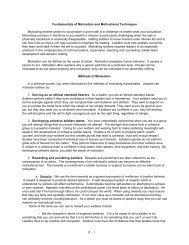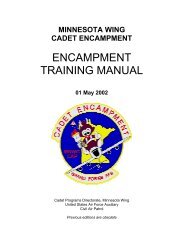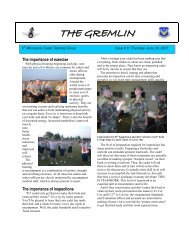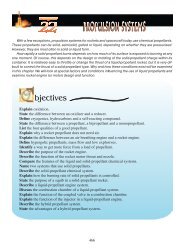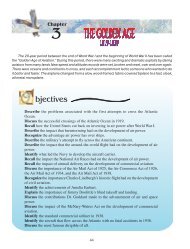hidden areas can act as cultural hooks that hang us upand lead to ambiguity, confusion, and misunderstanding.BehaviorsYour ability to interpret behaviors when negotiating indivergent cultural contexts is important. You may neverlearn to make the distinctive “snap” that ends a Liberianhandshake or use stainless steel chopsticks as deftly as aKorean. And that’s OK. What is important is being opento divergent cultural behaviors and withholding judgment.Of course, no matter how hard you try, you will still makemistakes. Once as a member of an American negotiatingteam in Japan, I was asked to present a proposal to aJapanese university’s chief administrators. I felt proficientenough to outline the proposal in Japanese. To lighten theatmosphere, I decided to begin by telling a rather blandjoke about jetlag. I practiced until I had it down pat.Much to my chagrin, however, the punch-line was metwith stony silence. What I learned afterwards was that inJapan jokes are inappropriate in formal contexts. I wouldhave been better served had I begun with a humble apologyfor the inadequacies of our proposal. Humility, not humor,is the acceptable opening for such proceedings. Fortunately,in spite of my clumsy introduction, the proposal was accepted.These kinds of cultural mistakes are part of the learningprocess. Most people will understand if you acknowledgeyou have made a mistake and seek to make amends.In fact, such mistakes will occur frequently in any situationwhere people from diverse cultural contexts collaborateand work together. Coalition teams, for example, providefertile ground for misunderstandings and conflict. Theability to resolve cultural conflict issues requires patienceand openness to differences in behaviors and institutionalpractices.Cultural Values, Beliefs, and AssumptionsCultural values, beliefs, and assumptions are powerfulforces within a culture. They are passed down from generationto generation through the family, schools, themedia, and religious institutions. Although hidden fromour view below the “waterline,” these shared concepts arethe foundation for all those aspects that are easily perceived.Although it may be convenient to categorize culturesby their values and norms, some caution is needed.In any culture, not all members display or “buy into”these psychological structures. Everyone in a culture isnot the same. Therefore, when talking about values,beliefs, and assumptions it is wise to frame them as generalizations.It is better to say that Iraqis, for example, “tendto be” collectivist or that American institutions “in general”support individualist values. To do otherwise is to fallinto the trap of stereotyping. 10InstitutionsInstitutions, according to Brett, are “economic, social,political, legal, religious institutional environments thateffect negotiation.” 11 This includes governmental organizationssuch as the military. Like behaviors, institutionalstructures are linked to cultural values and beliefs. Forexample, the fictional nation of Leonia is an Arab Muslimculture situated in the Maghreb region of NorthernAfrica. Cultures in this region tend to be much more hierarchicalthan those in the West. Yet there are benefits tothis type of organizational structure. In some cases, suchhierarchies allow even low level functionaries to havedirect access to management at a much higher level thanwould be common or even acceptable in the U.S. Sometimesit simply means finding out whom to contact togain access to decision-makers. This requires the formingof alliances, locating third-party intermediaries, and thedevelopment of friendships and strong working relationshipswith host country nationals.ReframingWhen we call someone lazy, we are making a judgmentabout that person’s character. When applied to a group,the judgment has been transformed into a negativestereotype because the attribution is not to just one person,but an entire group and by extension an entire culture.This kind of stereotyping is inappropriate. Before makingsuch sweeping judgments, [you] must clearly define thenegative behavior and then determine the cause. Theroots of the behavior are more likely tied to values relatedto cultural domains such as kinship, education, or institutionalprocesses. “Reframing” is a helpful process formoving beyond stereotyping and judgmental language.Stella Ting-Toomey and Leeva Chung, two recognizedexperts in the field of intercultural conflict resolution,described “reframing” as a communication skill that uses“neutrally toned (to positively-toned) language…to reducetension and increase understanding.” 12 The AFINT instructorscould begin the process of understanding theproblem by framing their descriptions of behavior in nonjudgmentalterms:Judgmental Statement“The students are lazy.”“The students are unmotivated.”Reframed StatementSome students turn in their homework either late orincomplete.Some students come to class 5 to 15 minutes late.Some students have missed up to three days of class.Values-Based NegotiationThe story of the sisters and the orange highlights theimportance of understanding the interests of all parties142
concerned. And, as previously stated, interests are theunderlying reason for entering a negotiation. Brett’s suggestionfor discovering the interests of the other party is toask the questions “Why?” and “Why not?” But Brett alsocautioned that “such direct questioning might not workeverywhere in the world.” 13 In many other cultures, askingdirect questions is seen as aggressive and intrusive behavior.When engaging in cross-cultural negotiation, one is betterserved by uncovering both values and interests. Quiteoften the two are entwined. As John Forester pointed outin his article “Dealing with Deep Value Differences,”“values run deeper than interests.” 14 He goes on to explainhow interests—such as time or money—are shed moreeasily than cultural values because:When we give up something we value, we often feel wegive up part of ourselves, and that’s very difficult, verythreatening, and hardly compensated by some gain somewhereelse. 15If we return to the situation at the Camp David Accords,we can see how closely cultural factors are enmeshedwith interests. Carter wrote that “there was no compatibilityat all” between Sadat and Begin. 16 Yet with the U.S.president acting as a bridge, Sadat and Begin were able toovercome cultural and political differences. The culturalfactors ran deep on both sides. Begin’s decision to removethe Israeli settlements was a difficult one for a man whosepeople had forged a new nation in what they believed tobe their Promised Land after centuries of persecution.Carter called this concession “a remarkable demonstrationof courage, political courage, on the part of PrimeMinister Begin.” 17As Carter did with Sadat and Begin, [you] would do wellto discover the values influencing the institutional andpersonal behavior causing conflict before [you] commenceany formal attempts to resolve the issues.To summarize, cross-cultural negotiations and conflictresolution require attention to values, beliefs, and otherpsychological aspects of culture that go hand in hand witha group’s specific interests. An understanding of theseareas is the key to a satisfactory resolution or agreement.INTERCULTURAL CONFLICT STYLESIn their book, Managing Intercultural Conflict Effectively,Stella Ting-Toomey and John Oetzel, define crossculturalconflict as:The experience of emotional frustration in conjunctionwith perceived incompatibility of values,norms,…goals, scarce resources, processes, and/oroutcomes between…parties from different culturalcommunities. 18Clearly, negotiation and conflict are closely linked.Understanding how conflict is displayed in divergent culturalcontexts can benefit planners engaged in crossculturalnegotiations. It also serves as a helpful guide inpreparing for any negotiation. This section will introduceyou to the phenomena of thin-slicing, mind-blindness,and the ICS-DEAD model of intercultural conflict styles.Thin-Slicing and Mind-BlindnessIn his bestselling book Blink, Malcolm Gladwell describedthe phenomenon of rapid cognition known as thin-slicing. 19Thin-slicing is the human ability to use “our unconsciousto find patterns in situations and behavior based on verynarrow slices of experience.” 20 Thin-slicing is used constantlyin human interaction as we read the meaning of aglance or a tone of voice. We also thin-slice our waythrough disagreements and conflict situations. Althoughthe ability to thin-slice is innate, the patterns that frameour ability to slice and dice are learned.The inability to thin-slice is a condition common to thosesuffering from autism. People with autism, according toGladwell,“find it difficult, if not impossible to…[interpret]nonverbal cues, such as gestures and facial expressionsor putting themselves inside someone else’shead or drawing understanding from anythingother than the literal meaning of words.” 21This is exactly what happens when human beings crossinto new cultural terrain. In a cross-cultural situation,this temporarily autistic condition, a mental state thatGladwell calls “mind-blindness,” causes us to miss thecues and clues that in our own culture—in an instant—would tell us what is happening. 22 To overcome thiscultural mind-blindness, it is essential that we build theintercultural skills that widen our emotional radar andother sensory receptors and pick up those clues andawarenesses we would otherwise miss.Intercultural Conflict Styles—The DEAD ModelMitchell Hammer defined conflict style as interactionalbehavior that “reflects specific…patterns or tendenciesfor dealing with disagreements across a variety of situations.”23 To offset the effects of mind-blindness, recognizecultural differences, and help us read the dynamics ofcross-cultural conflict situations, Hammer has devised aneasy to understand framework that identify differences inconflict style when negotiating across cultures. An awardwinningauthor 24 and researcher in the field of crisismediation and conflict resolution, Hammer’s InterculturalConflict Styles (ICS-DEAD) framework looks at crossculturalconflict from a culturally generalizable perspective.The ICS-DEAD describes four general cultural patterns143
- Page 1 and 2:
VOLUME FOUR STRATEGIC PERSPECTIVESL
- Page 3 and 4:
VOLUME FOUR STRATEGIC PERSPECTIVESL
- Page 5 and 6:
VOLUME FOUR STRATEGIC PERSPECTIVESL
- Page 7:
VOLUME FOUR STRATEGIC PERSPECTIVESL
- Page 10 and 11:
12CHAPTER 12INTRODUCTION TO STRATEG
- Page 12 and 13:
12.1 Strategic Leadership: Defining
- Page 14 and 15:
mandates or resolutions that would
- Page 16 and 17:
and ambiguity, aspiring strategic l
- Page 18 and 19:
12.2 National Security StrategyThe
- Page 20 and 21:
within our borders has always been
- Page 22 and 23:
front common challenges like violen
- Page 24 and 25:
and our strategy, not sector earmar
- Page 26 and 27:
thinking about organizations. She m
- Page 28 and 29:
A systemic approach to failure is m
- Page 30 and 31:
The late W. T. Grant Company is a r
- Page 32 and 33:
the resources - setting the directi
- Page 34 and 35:
focal point for describing and inte
- Page 36 and 37:
Consequently, we do not restrict th
- Page 38 and 39:
paragraphs, Web pages, then edit an
- Page 40 and 41:
Web, can be viewed as a CS attempt
- Page 42 and 43:
How to evaluate users and contribut
- Page 44 and 45:
13CHAPTER 13LEADING PUBLIC &VOLUNTE
- Page 46 and 47:
13.1 Leadership for Volunteers:The
- Page 48 and 49:
13.2 Take Root: Volunteer Managemen
- Page 50 and 51:
QualificationsClearly list educatio
- Page 52 and 53:
and effectively track their volunte
- Page 54 and 55:
• Understand rules for recognitio
- Page 56 and 57:
• Send a birthday card.• Submit
- Page 58 and 59:
and tested more than six decades af
- Page 60 and 61:
specific interests of the donors, v
- Page 62 and 63:
tain) tax-exempt status from the In
- Page 64 and 65:
Smucker, 1999).The Internal Revenue
- Page 66 and 67:
culture is necessary to ensure the
- Page 68 and 69:
13.4 The New Look of TransparencyBy
- Page 70 and 71:
ees for a couple of reasons: One, i
- Page 72 and 73:
13.5 Public and Private Management:
- Page 74 and 75:
TABLE 1:FUNCTIONS OF GENERAL MANAGE
- Page 76 and 77:
3. Career System. The model corpora
- Page 78 and 79:
islative charter - the Clean Air Ac
- Page 80 and 81:
In controlling performance, Chapin
- Page 82 and 83:
14CHAPTER 14AIRPOWER ASSTRATEGIC LA
- Page 84 and 85:
14.1 Strategic Air Power: Fulfillme
- Page 86 and 87:
carry it out. Their daylight raids
- Page 88 and 89:
you did not rely on strategic bombi
- Page 90 and 91:
14.2 Warden and the Air Corps Tacti
- Page 92 and 93:
ecomes one of applying sufficient i
- Page 94 and 95: tification, and a Jominian claim to
- Page 96 and 97: courage the rapid and widespread ex
- Page 98 and 99: it to influence physical players in
- Page 100 and 101: 14.4 Basic Air Force DoctrineAF Doc
- Page 102 and 103: earthquake-stricken Haiti. The worl
- Page 104 and 105: perspective. Airmen do not divide u
- Page 106 and 107: Command and ControlCommand and cont
- Page 108 and 109: 14.5 Should the US Maintain the Nuc
- Page 110 and 111: form of human government.” 20 Dem
- Page 112 and 113: obtainable goal. See the Global Zer
- Page 114 and 115: 15CHAPTER 15ORGANIZATIONAL CULTURE
- Page 116 and 117: 15.1 Organizational CultureBy Doria
- Page 118 and 119: Review. This action strives to unco
- Page 120 and 121: gram will serve and then having the
- Page 122 and 123: ticipating the changes being made b
- Page 124 and 125: Many years of working with change p
- Page 126 and 127: At the least, the areas of concern
- Page 128 and 129: 15.4 Developing an Innovative Cultu
- Page 130 and 131: CONCLUDING THOUGHTSIn an ever-chang
- Page 132 and 133: global issues. Businesses that poss
- Page 134 and 135: — Sees the big picture—the shif
- Page 136 and 137: 16CHAPTER 16STRATEGIC COMMUNICATION
- Page 138 and 139: 16.1 Principles of Strategic Commun
- Page 140 and 141: 16.2 The Art of NegotiationBy Brend
- Page 142 and 143: 16.3 Negotiating Effectively Across
- Page 146 and 147: and four conflict styles. Hammer be
- Page 148 and 149: maintaining the relationship. As th
- Page 150 and 151: 25 Mitchell R. Hammer, “Chapter 1
- Page 152 and 153: tural, socioeconomic, and psycholog
- Page 154 and 155: for the win-win," during which time
- Page 156 and 157: interests and, at worst, as a gun s
- Page 158 and 159: Public diplomacy is surely about mu
- Page 160 and 161: But public diplomats do not have th
- Page 162 and 163: Photo courtesy of the familyThe LEA
- Page 164: THE CADET OATHI pledge that I will



